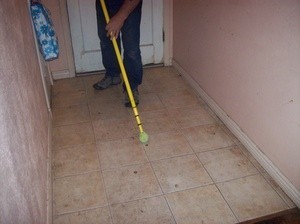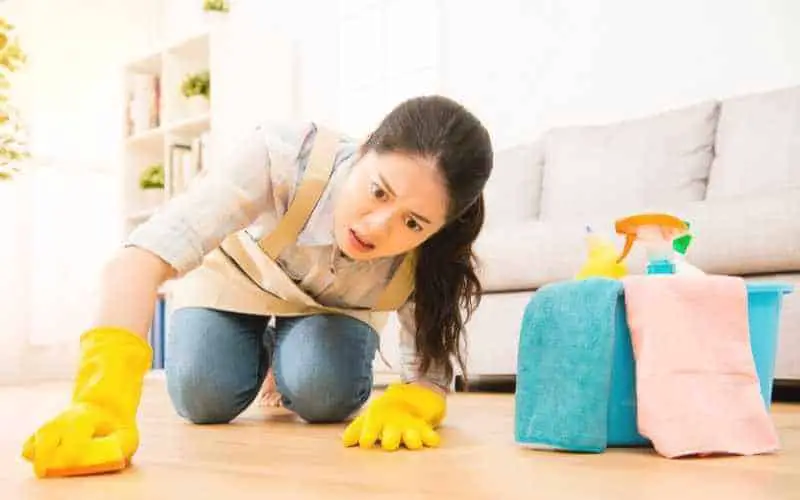Have you ever looked down at your gleaming hardwood floors only to see an unwelcome surprise – a stubborn scuff mark? It can be frustrating to see these blemishes marring the beauty of your home, especially when you’ve gone through the effort of maintaining them. But don’t despair! Removing scuff marks from hardwood floors is achievable, and this guide will equip you with the knowledge and techniques to tackle them head-on.

Image: www.thriftyfun.com
Whether it’s from furniture dragging across the floor, errant shoes, or the inevitable wear and tear of daily life, scuff marks can make your hardwood floors look dull and outdated. This article will delve into the various methods for removing scuff marks, exploring the best options for different types of marks and wood finishes. We will also examine preventative measures you can take to minimize the occurrence of scuff marks in the first place, ensuring your hardwood floors stay stunning for years to come.
Understanding the Enemy: Types of Scuff Marks
Before diving into the removal methods, it’s essential to understand the different types of scuff marks you might encounter. This will help you choose the most effective approach. Here’s a breakdown:
1. Light Scuff Marks
These are typically caused by soft materials like socks, rubber soles, or light furniture dragging. They usually appear as faint lines or streaks. These are often the easiest to remove.
2. Medium Scuff Marks
These are more visible and more stubborn, often caused by harder materials like leather soles or heavier objects. These might leave darker lines or indentations on the surface.

Image: floorcarekits.com
3. Deep Scuff Marks
These are the most challenging to remove and can even damage the finish. They are typically caused by heavy furniture, sharp objects, or prolonged abrasive contact. Deep scuff marks might require more specialized treatments or even professional intervention.
The Arsenal: Unveiling the Best Tools for the Job
Equipped with an understanding of the different scuff mark types, let’s explore the most effective tools and techniques for tackling them:
1. Cleaning Supplies: Your Basic Line of Defense
Before resorting to more aggressive methods, always try a gentle cleaning approach first. Here’s what you’ll need:
- Microfiber Cloth: This soft, absorbent cloth is ideal for wiping away dust, dirt, and grime that could be contributing to the scuff marks.
- Warm Water: A simple warm water solution can often loosen dirt and grime and help lift away light scuff marks.
- Mild Dish Soap: A drop of mild dish soap, like Dawn, mixed with warm water can create a gentle cleaning solution for removing light scuff marks.
- White Vinegar: White vinegar is a natural cleaning agent that can cut through grease and grime and even help remove water stains. Dilute it with water (1:1 ratio) for a safe cleaning solution.
- Baking Soda: Baking soda acts as a gentle abrasive that can help remove scuff marks without damaging the floor’s finish. Combine it with a small amount of water to create a paste.
2. Refinishing Products: Restoring Your Floor’s Glory
For deeper scuff marks or when you want to restore your floor’s shine, consider these tools:
- Wood Floor Cleaner: Look for a cleaner specifically designed for hardwood floors. They remove dirt, grime, and polish without damaging the finish.
- Wood Floor Polish: A good quality polish can help fill in minor scratches and scuff marks, restoring the floor’s shine and protecting it from future damage.
- Sandpaper: Use fine-grit sandpaper (120-180 grit) carefully for deeper scuff marks, but be cautious as excessive sanding can damage the floor’s finish.
- Wood Floor Refinishing Kit: For significant damage or heavily scuffed floors, a refinishing kit can restore the surface to its original beauty. It involves sanding, staining, and sealing the floor.
The Tactics: Mastering Scuff Mark Removal Techniques
Now that you’ve got your tools ready, it’s time to put them into action. Here’s a step-by-step guide for removing scuff marks:
1. Preparation is Key: Get Ready for Battle
Before you start cleaning, clear the area around the scuff mark. Remove furniture, rugs, and any other obstacles. Sweep or vacuum the floor to remove loose dust and debris. This ensures a clean surface for effective removal.
2. The Gentle Touch: Start with Basic Cleaning
Begin by trying a gentle cleaning method, such as wiping the scuff mark with a damp microfiber cloth or a mild soap solution. Gently rub the area, focusing on the scuff mark. If the mark is light, this might be enough to remove it.
3. Embrace the Power of Nature: Vinegar and Baking Soda
For tougher scuff marks, you can try a vinegar and baking soda solution. Mix equal parts of white vinegar and water in a spray bottle. Spray the solution directly onto the scuff mark and scrub gently with a microfiber cloth. You can also use a paste made from baking soda and water for more abrasive cleaning.
4. The Final Frontier: Polishing and Refinishing
If the scuff mark persists, it might be time to resort to more advanced techniques. Use a wood floor cleaner to remove residual dirt and grime. Apply a wood floor polish to fill in minor scratches and scuff marks and restore shine. For deeper marks, consider using fine-grit sandpaper (120-180 grit) to lightly sand the area. Be careful not to sand too hard, as this can damage the floor’s finish. If the damage is extensive, a professional refinishing kit or a professional wood floor refinisher may be necessary.
Preventative Measures: Keep Those Scuff Marks at Bay
Proactive measures are crucial in preventing scuff marks from becoming a recurring problem. Here are some tips to keep your hardwood floors looking their best:
- Place Furniture Pads: Attach felt or rubber pads to the legs of chairs, tables, and other furniture to minimize dragging and scuffing.
- Use Protective Mats: Place mats in high-traffic areas like entryways and kitchens to reduce wear and tear on your floors.
- Regular Cleaning: Regularly sweep or vacuum your floors to remove dirt and debris that can contribute to scuff marks.
- Remove Shoes at the Door: Encourage family members and guests to remove their shoes before entering to prevent dirt and grime from being tracked onto your floors.
- Protect Against Water Damage: Clean up spills promptly as water can damage your floor’s finish and create conditions for scuff marks.
Additional Tips for Success
Here are a few extra tips to ensure you get the best results:
- Test a Hidden Spot: Before using any new cleaning product or technique, always test it on a hidden spot on your floor to ensure it doesn’t damage the finish.
- Work in Small Sections: Don’t try to tackle an entire floor at once. Focus on one section at a time to ensure thorough cleaning and prevent overuse of cleaning products.
- Be Patient and Persistent: Removing scuff marks can sometimes take time and persistence. Don’t give up too easily. A little effort and patience can restore your floor’s beauty.
Best Way To Get Scuff Marks Off Hardwood Floors
Conclusion
Scuff marks may seem like an inevitable part of owning hardwood floors, but they are not unbeatable. Armed with the right knowledge and tools, you can banish these blemishes and restore your floors to their former glory. Remember to choose the appropriate technique based on the type of scuff mark and your floor’s finish. Follow the preventive measures outlined to minimize future scuffing and keep your hardwood floors shining for years to come. If you ever find yourself facing particularly stubborn scuff marks or extensive damage, consult with a professional wood floor specialist. They can provide expert advice and, if needed, perform professional refinishing to restore your floors to their original beauty.





